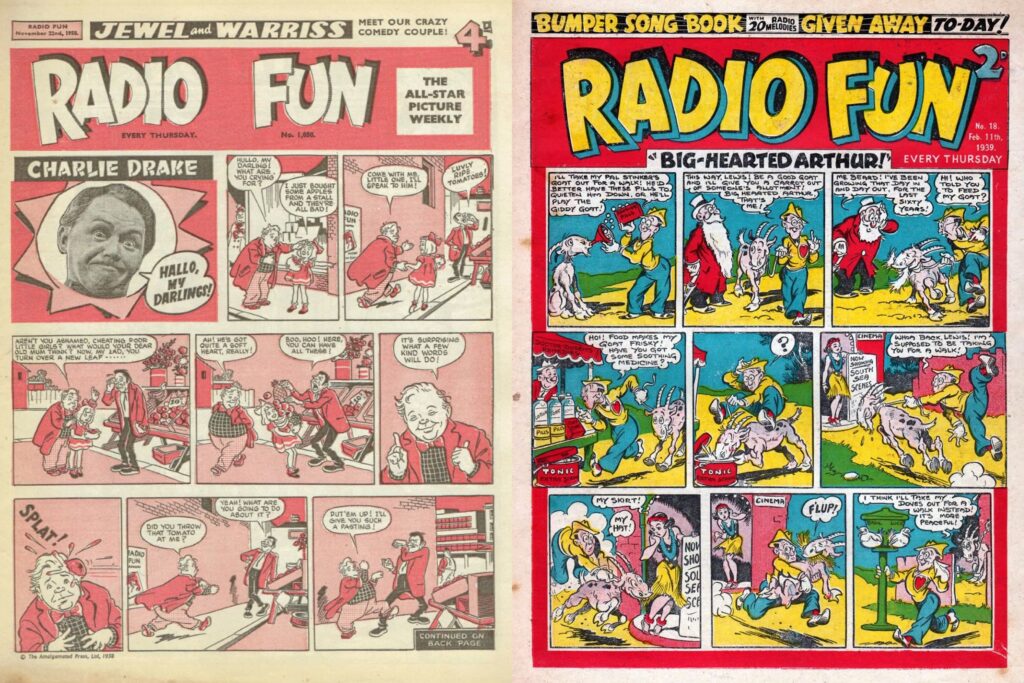Radio Fun was a prominent British celebrity comic comic paper that entertained readers from October 15, 1938, to February 18, 1961. During its publication run, it became a beloved source of entertainment for many, featuring a variety of humorous comic strips and captivating stories. Let’s delve into this iconic publication’s rich history and engaging content.
| Radio Fun | |
|---|---|
| Publication Dates | 15 October 1938 – 18 February 1961 |
| Publisher | Amalgamated Press (1938–1959) Fleetway Publications (1959–1961) |
| Genre | Action/adventure, humor/comedy |
| No. of Issues | 1167 |
| Strips | |
| Arthur Askey Benny Hill Bernard Bresslaw Charlie Chester Petula Clark Charlie Drake Clark Gable Tommy Handley Jimmy Jewel and Ben Warriss Tom Keene Sandy Powell Jack Warner Norman Wisdom | |

Publication Information
Radio Fun was initially published by Amalgamated Press from 1938 to 1959, after which Fleetway Publications took over until its final issue in 1961. With a focus on action/adventure and humor/comedy, Radio Fun has delighted readers with its entertaining content for over two decades. Across its lifespan, the publication released 1,167 issues, showcasing its enduring popularity and influence in the comics industry.

Publication History
During its illustrious history, Radio Fun experienced several notable developments and mergers. Wonder, another comic title, merged with Radio Fun in 1953, adding to its impressive content lineup. Towards the end of its run, the title evolved into Radio Fun and Adventures, signaling a shift in focus while retaining its signature humor and entertainment value. With each issue, Radio Fun continued to captivate readers with its engaging stories and lively characters.

Strips
One of the standout features of Radio Fun was its wide array of comic strip versions of radio and film stars. These strips brought beloved personalities to life on the pages of the comic, entertaining readers with their humorous antics and larger-than-life adventures. Some of the notable celebrities featured in Radio Fun included Arthur Askey, Benny Hill, Bernard Bresslaw, Charlie Chester, Petula Clark, Charlie Drake, Clark Gable, Tommy Handley, Jimmy Jewel and Ben Warriss, Tom Keene, Sandy Powell, Jack Warner, and Norman Wisdom.

In addition to its celebrity strips, Radio Fun also introduced readers to popular characters from other mediums. Towards its final years, the comic featured an abridged and reformatted Superman strip sourced from DC Comics, further diversifying its content and appealing to a broader audience. Other cover strips included The Falcon and Wagon Train, offering readers a mix of action, adventure, and humor.

Legacy:
Radio Fun holds a special place in the hearts of readers who grew up with its lively comic strips and humorous content. Its enduring legacy is a testament to its ability to capture the spirit of the times and bring joy to audiences of all ages. Though it may have merged with Buster in 1961, the memories and laughter it provided continue to resonate with fans today.

Conclusion
Radio Fun holds a special place in the hearts of many comic enthusiasts, offering a unique blend of humor, adventure, and celebrity entertainment. With its memorable characters, engaging stories, and iconic artwork, Radio Fun left an indelible mark on the comics landscape during its remarkable run. As readers reminisce about the joyous moments spent flipping through its pages, Radio Fun remains a cherished and beloved part of British comic history.
Frequently Asked Questions (FAQs) about Radio Fun:
1. What was Radio Fun?
Radio Fun was a British celebrity comic paper that entertained readers from October 15, 1938, to February 18, 1961. It featured comic strip versions of radio and film stars, blending action/adventure with humor/comedy content.
2. Who published Radio Fun?
Radio Fun was initially published by Amalgamated Press from 1938 to 1959. Fleetway Publications took over the publishing duties from 1959 until the end of its run in 1961.
3. How many Radio Fun issues were published?
Radio Fun released 1167 issues during its lifespan, showcasing many comic strips and entertaining content.
4. What kind of content did Radio Fun feature?
Radio Fun primarily featured comic strip adaptations of radio and film stars, including Arthur Askey, Benny Hill, Bernard Bresslaw, Charlie Chester, and more. It also included humor/comedy content packed with gags and slapstick situations.
5. Did Radio Fun undergo any mergers or transformations?
Yes, Radio Fun experienced mergers and transformations during its publication history. Wonder merged with Radio Fun in 1953, and towards the end of its run, the title evolved into Radio Fun and Adventures, offering thrilling adventures alongside its humorous content.
6. Who were some of the contributing artists to Radio Fun?
While some contributions were uncredited, notable industry regulars such as Roy Wilson and George and Reg Parlett played significant roles in shaping Radio Fun’s distinctive style and entertaining comic strips.
7. What was the legacy of Radio Fun?
Radio Fun holds a special place in the hearts of readers who grew up with its lively comic strips and humorous content. Its enduring legacy reflects its ability to capture the spirit of the times and bring joy to audiences of all ages.
8. What sets Radio Fun apart from other comics of its time?
Radio Fun stood out for its unique blend of celebrity comics featuring beloved radio and film stars and its emphasis on humor and slapstick situations. Its ability to entertain and engage readers made it a cherished publication during its time.
9. Are there any notable strips or characters featured in Radio Fun?
Yes, Radio Fun introduced readers to memorable characters, including adaptations of popular radio and film stars like Arthur Askey, Benny Hill, and Charlie Chester. The comic also featured a Superman strip adapted from DC Comics in its later years.
10. Where can I find copies of Radio Fun today?
Copies of Radio Fun may be available in vintage comic collections, online marketplaces, or through collectors’ networks. While the original print copies may be rare, digital archives and reprints may offer opportunities for fans to revisit this classic comic paper.
This post was created with our nice and easy submission form. Create your post!





2 Comments